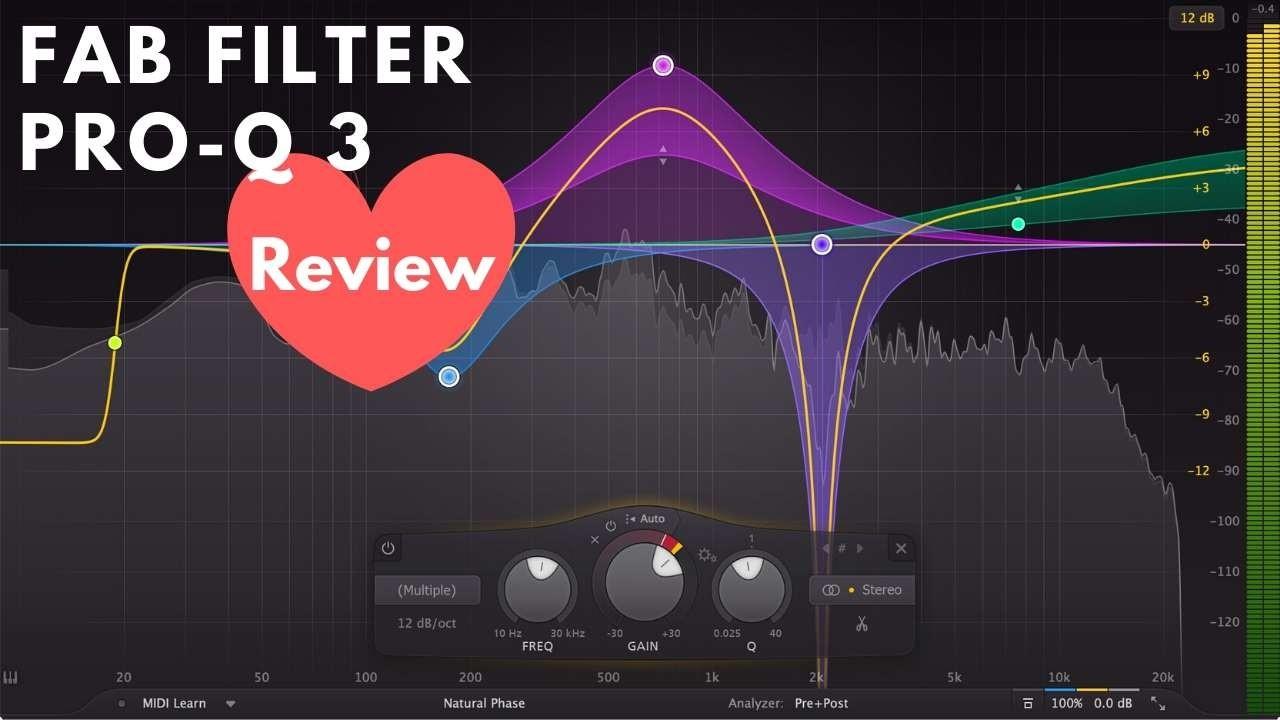Fab Filter Pro-Q 3 Review & Tips

I’ve tried a lot of EQs in my life. Each one promising some incredible vintage model the promised to make my life better. To be honest, none of them really have done much for me – until the FabFilter Pro-Q 3.
And that’s not hype (you can watch my Fab Filter Pro-Q 3 review and see I’m not lying – I’ve got a terrible poker face).
You see, the Pro-Q 3 doesn’t emulate any legendary device, it doesn’t do saturation, it doesn’t have any magic fairy dust. It just lets you make smart, well-informed mixing decisions.
Unlike other plugins, it presents you with tons of extra information that allows you to be a better mixer. And when you use EQ better, you don’t need any fairy dust.
It’s also loaded with amazing features like mid-side processing, dynamic EQ, and a spiffy visualizer. I did a whole post here on how powerful mixing with the Pro-Q 3 can be. Plus there’s a ton of curve shapes, from filters to shelves. And with adjustable slopes to help you target those hard to reach frequencies.
The best way to use it, in my opinion, is to put a Fab Filter on every channel and do all of your subtractive EQ in it. Then, if you want that vintage saturated fairy dust sound, insert your other additive EQs after the Pro-Q 3. I found this gives me great results and really doesn’t slow down my workflow significantly.
It can also be great on the master buss thanks to the Pro-Q 3’s surgical curves and excellent analytical tools. Just be sure that any edits you do to the master buss are subtle and limited to a couple dB or less.
If you want to check it out for yourself you can buy it here. This Fab Filter Pro-Q 3 review is based on a free review copy.
Mixing Tips With Fab Filter Pro-Q 3
Fab Filter’s new Pro-Q 3 EQ is an incredibly powerful piece of engineering.
In this post, I want to share with you how you can use some of the incredible features in the Pro-Q 3 to take your mixing skills to the next level. You see, the Pro-Q 3 provides a host of tools to educate you as a mixer and start making smarter, more informed choices.
For example, if you have Pro-Q 3s in multiple channels, you can compare them to see where the frequency overlaps and gets muddy. For example, you could quickly see what frequency range your bass and kick drum are conflicting, then decide which you’d like to cut.
The Pro-Q3 also provides the ability to solo the frequency range you’re working with so you can really hear what 3k on a guitar sounds like. I couldn’t believe how different some EQ moves were from my expectations. On top of this, the Pro-Q 3 has a robust graphic interface displaying the waveforms.
The Pro-Q3 is also great for helping your mixing education because it’s an all-in-one EQ tool. You can make EQ adjustments to in regular mode, or mid/side mode, or even to just one side. Having quick access to all these different modes means you can experiment with more advanced quickly, without having to reach for a different plugin. Similarly, the Pro-Q3 can act as a dynamic EQ, ducking frequencies out of the way.
You can buy the Pro-Q3 here.
How to use EQ Guides
To help you get the most out of your EQ plugins, we've put together these detailed guides to teach you how to use EQ on some of the most popular instruments.
From a Frustrated Producer in a Ragtag Bedroom Studio to Major Placements on TV Earning $1,000s!
My name is Evan, and I've been making music since around 3rd grade. I'm from San Diego, California, but I've lived in Washington, DC for the last 20 years.
While I still have a full-time day job, I have created systems that have allowed me to produce dozens of songs a year in my spare time.
My songs have been on Netflix, TV shows like the 90 Day Fiance, an award-winning indie film, and NPR’s “All Thing Considered.” They've also been streamed millions of times.
In addition to being a music producer, I am passionate about teaching people how they can make professional-sounding music and earn money licensing it, all in their spare time.
Thousands of musicians, like yourself, have trusted me to guide their musical journey. My YouTube videos have been watched nearly a million times. And my story has been in Forbes, Side Hustle Nation, and the Side Hustle School.






